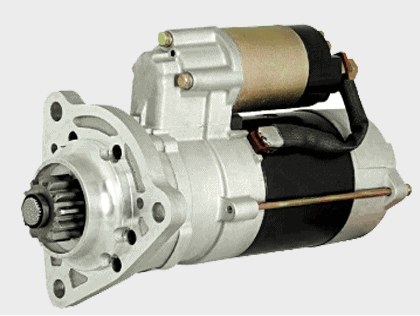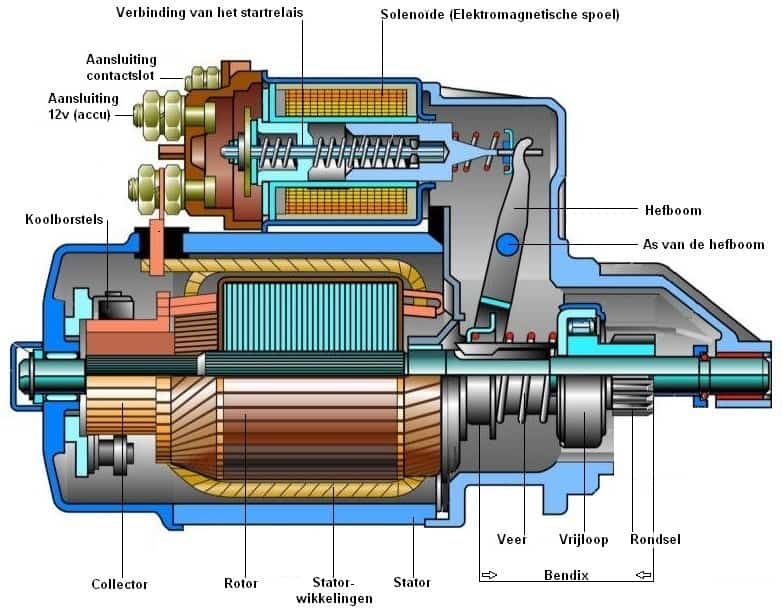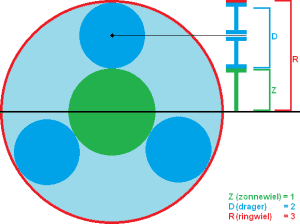Subjects:
- General
- Operation
- Solenoid
- Bendix
- freewheel
- Planetary Gear System
- Possible starter motor failure
General:
A starter motor is mounted on every combustion engine (petrol/diesel). This starter motor ensures that the engine is started. The pinion of the starter motor engages the gear ring of the flywheel, after which the flywheel is set in motion. An engine must have a certain starting speed to initiate the four-stroke process (intake stroke-compression stroke-power stroke-exhaust stroke). The cranking speed must be high enough to start the engine.
A starter motor is a DC motor, which is directly connected to the battery with a thick positive cable. This is done because very (high) powerful currents (and therefore also heat) pass through it. The starter motor converts electrical energy into kinetic energy.

Operation:
The starter motor is always mounted near the flywheel. When switching on the starter motor, the pinion (while turning by means of the bendix) engages in the teeth of the flywheel. The flywheel will then turn. There are two electrical connections on the starter motor; one for the signal wire coming from the ignition switch (terminal 50) and one for the positive wire from the battery (terminal 30). Sometimes the connection from the ignition is made as a plug connection instead of a screw connection (see image below).
When the key is turned in the ignition lock as far as it will go to start, a voltage of 12 Volts is applied to the ignition lock terminal (terminal 50) of the starter motor. This signal energizes the solenoid and current flows from the 12v connection through the coils. The operation of the solenoid is about the same as that of a normal relay; from a small control current a large main current is made. The solenoid is only made a lot bigger, because very large currents pass through it. The moment the solenoid is energized, the starter motor will spin.
Solenoid:
A solenoid is an electromagnetic component. When a current flows through the solenoid, it becomes magnetic. This magnetic effect allows a component to be moved mechanically, just like a commonly used relay which, for example, switch on the lights and windshield wipers. In this case, the two connections of the starter relay are pulled together by the magnetic action.

At the moment that it is started, a control current is applied to the “connection ignition lock”. The voltage on the “connection 12v (battery)” is then switched in the solenoid. The carbon brushes transmit the voltage to the collector. The north and south poles in the rotor ultimately cause forceful movement in the stator; the electric motor will run.
The lever is pulled to the left by the solenoid at the top. The bottom of the lever will move to the right due to the (blue) pivot point. This pushes the pinion gear into the flywheel sprocket with a rotating movement. The rotor will then start to rotate, eventually setting the flywheel in motion. The combustion engine of the car will be driven at a certain speed (eg 400 rpm). The engine management system of the car ensures, among other things, the supply of the correct amount of fuel during starting, so that the engine will start after a few crankshaft revolutions.
bendix:
The whole of the spring, freewheel and pinion is called the bendix. In this bendix a horizontal movement is made (in the image from left to right). The bendix also ensures that the pinion makes a rotating movement when moving outwards. This will prevent the pinion teeth from colliding with the starter gear teeth, which could prevent the pinion teeth from engaging the starter gear but against the flywheel teeth.
After the engine has started, the pinion is pulled back in. This is sometimes accompanied by a whooping sound. This problem can be (temporarily) resolved by cleaning and greasing the bendix. It's not harmful, just annoying.
Freewheel:
When the combustion engine starts after starting, it will run at a higher speed (eg 800 rpm). This is the double speed that the starter motor turns. At the moment of starting the engine, the pinion is still engaged with the flywheel of the engine. This also causes the pinion to rotate at twice the speed. To prevent damage to the starter motor, a freewheel section is fitted in front of the pinion. The freewheel prevents the motor from driving the starter motor rotor; the starter motor will therefore not operate at the engine speed of 800 rpm. can get involved.
The freewheel can be seen as two rings that are connected to each other with bearings. The outer ring can only turn in one direction (for example counterclockwise). When the direction of movement reverses (clockwise), the freewheel will cause the outer ring to lock. The inner and outer ring are then connected to each other. Only when the outer ring is turned counterclockwise again, a movement between the two will be possible again.
Planetary Gear System:
Certain starter motors are equipped with a so-called planetary gear system, which is also used in an automatic gearbox. This gear system provides a different transmission ratio and is often placed in front of the bendix. Reducing the speed of the pinion (relative to the rotor) results in an increase in torque. An electric motor has the highest torque at a low speed. With a planetary gear system, a greater torque (i.e. more force) can be transferred to the starter ring at a lower speed. View this page for an explanation of the planetary gear system.

Possible starter motor failures:
- When turning the key in the ignition nothing happens or only a 'click' sound is heard:
This can be the result of a dead battery. Due to an on-board voltage that is too low, the solenoid is energized (it gives a ticking sound), but the voltage is too low to drive the rotor. If the battery voltage is OK (minimum 10,5 volts) and the starter motor still does not work, it is possible that the solenoid is "hanging". The lever is then not actuated and nothing happens. By tapping the starter motor housing with a hammer (and possibly a screwdriver) (not too hard of course) in most cases the whole thing will come loose again, so that it can be started again. This is a problem that will certainly come back in the future, so it is time to make an appointment with a garage or overhaul company. - A very loud screeching noise is heard during start-up:
The bearing bushes are defective and must be replaced. Overhaul companies that mainly overhaul alternators and starter motors are specialized in this. - During starting, the starter motor slips for a moment (is accompanied by a grinding noise), then turns again a little further and slips again:
The starter ring on the flywheel is probably damaged. If the teeth are worn, the teeth of the starter motor pinion will slip over them. Possible causes are; accidentally operating the starter motor when the engine is already idling, or starting frequently (eg a training car or a courier's car that has been started several times a day for years). - Noise after the engine has started:
The possible cause of this is the bendix that "hangs". This can then be heard for about one to two seconds after the ignition key has been released. The bendix is described above.
